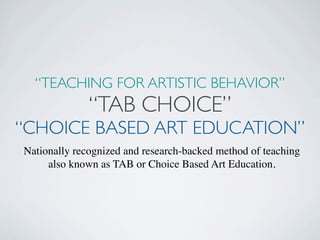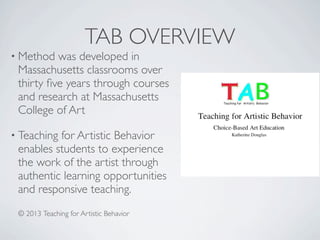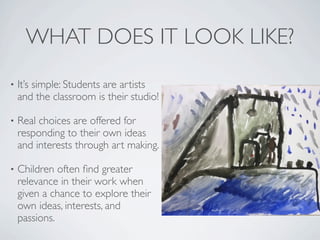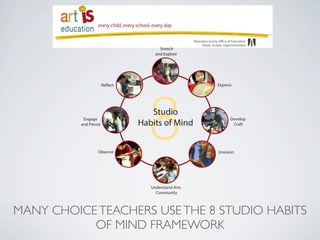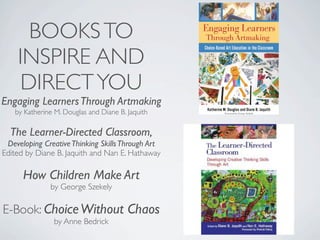Tab presentation
- 1. âTEACHING FOR ARTISTIC BEHAVIORâ âTAB CHOICEâ âCHOICE BASED ART EDUCATIONâ Nationally recognized and research-backed method of teaching also known as TAB or Choice Based Art Education.
- 2. TAB OVERVIEW âĒ Method was developed in Massachusetts classrooms over thirty ïŽve years through courses and research at Massachusetts College of Art âĒ Teaching for Artistic Behavior enables students to experience the work of the artist through authentic learning opportunities and responsive teaching. ÂĐ 2013 Teaching for Artistic Behavior
- 3. WHAT DOES IT LOOK LIKE? âĒ Itâs simple: Students are artists and the classroom is their studio! âĒ Real choices are offered for responding to their own ideas and interests through art making. âĒ Children often ïŽnd greater relevance in their work when given a chance to explore their own ideas, interests, and passions.
- 4. ESSENTIAL ELEMENTS OF A TAB CHOICE ART ROOM âĒ The student is the artist âĒ Students control subject matter, materials, approach âĒ Student beliefs drive work âĒ Students are self-motivated âĒ Experimentation are honored âĒ http:// and mistakes teachingforartisticbehavior.org/
- 5. This concept supports multiple modes of learning to meet the diverse needs of all students and contributes to 21st Century Skill sets desired by employers.
- 6. ACCORDING TO THE PARTNERSHIP FOR 21ST CENTURY SKILLS... The Arts are considered a core subject area. Learning and innovation are recognized as the skills that separate students who are prepared for complex life and work environments in the 21st century. They believe that a focus on creativity, critical thinking, communication and collaboration is essential to prepare students for the future. SpeciïŽcs on these skills are found here: http://www.p21.org/overview/skills-framework/60
- 7. THE PARTNERSHIP FOR 21ST CENTURY SKILLS SUGGESTS THAT STUDENTS... should develop more than just thinking skills and content knowledge. They should be able to: Adapt to Change Be Flexible Manage Goals and Time Work Independently Be Self Directed Learners Interact Effectively with Others Work in Diverse Teams Manage Projects Produce Results Guide and Lead Others Be Responsible to Others
- 8. Stretch and Explore Engage and Persist Observe 8 Studio Habits of Mind Express Develop Craft Envision Understand Arts Community Develop Craft: Learning to use tools, materials, artistic conventions; and learning to care for tools, materials, and space. MANY CHOICE TEACHERS USE THE 8 STUDIO HABITS OF MIND FRAMEWORK Engage & Persist: Learning to embrace problems of relevance within the art world and/or of personal importance, to develop focus conducive to working and persevering at tasks. Envision: Learning to picture mentally what cannot be directly observed and imagine possible next steps in making a piece. Express: Learning to create works that convey an idea, a feeling, or a personal meaning.
- 9. TAB TEACHERS SUPPORT EACH OTHER, SHARE, AND LEARN TOGETHER JOIN THE ONLINE PROFESSIONAL LEARNING COMMUNITY To learn more about TAB and choice-based teaching and learning visit our Yahoo Group, TAB-ChoiceArtEd & VISIT THEM ON FACEBOOK! Midwest TAB Art Teachers TAB Room Design
- 10. BOOKS TO INSPIRE AND DIRECT YOU Engaging Learners Through Artmaking by Katherine M. Douglas and Diane B. Jaquith The Learner-Directed Classroom, Developing Creative Thinking Skills Through Art Edited by Diane B. Jaquith and Nan E. Hathaway How Children Make Art by George Szekely E-Book: Choice Without Chaos by Anne Bedrick
- 11. CHOICE WITHOUT CHAOS an E-book by Anne Bedrick http://vimeo.com/47676569
- 12. YOU CAN TEACH FOR ARTISTIC BEHAVIOR! Start small and build up. Talk to others who have done it. Read everything you can get your hands on. Look at photos, blogs, and Facebook.

